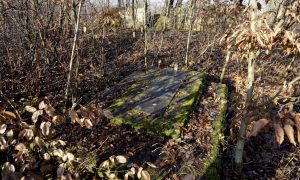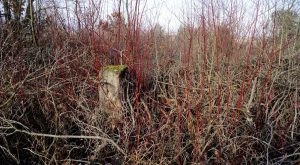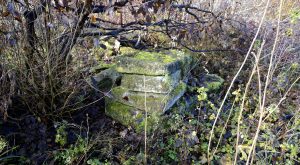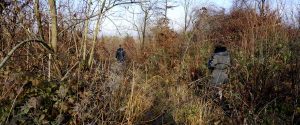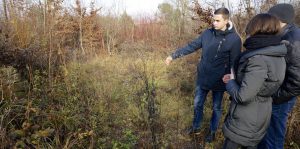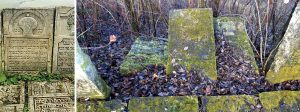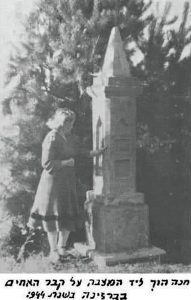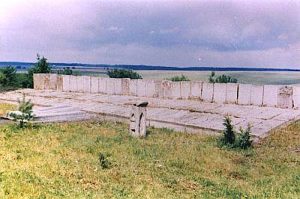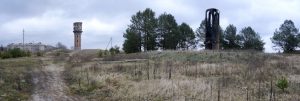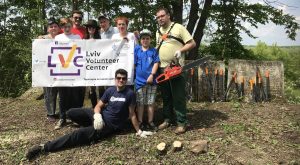![]() Ця сторінка також доступна українською.
Ця сторінка також доступна українською.
Introduction
This page summarizes and analyzes a past memorial monument project at the Jewish mass grave site north of Rudky in the Sambir raion of Lviv oblast in western Ukraine. The monument was assembled of Jewish headstones which had been stripped from Rudky’s two Jewish cemeteries during or after World War II, then later recovered, and built into a memorial wall as part of a complex of monuments constructed by survivors of the Holocaust and descendants of Jewish families who had emigrated before the war. The monument was originally well-arranged but was assembled without a solid foundation, and a lack of general maintenance including cutting and clearing of wild-growing vegetation in particular during the following three decades led to decay and disintegration of most of the assembled features at the mass grave site. Until recently the monument and the site have been derelict; since 2017 a local history and heritage activist has attempted to raise awareness of the site, to clear vegetation, and to repair and maintain the monument, but the project has not gained engagement from the local community or diaspora Jews, and still lacks administration and funding.
This page is intended as a reference for similar projects now in the planning stages in western Ukraine or beyond. Following a brief summary of the site, the material below describes the project and reviews its effectiveness together with a listing of issues encountered, approximate project costs, and ongoing risks. Related projects both in western Ukraine and elsewhere in Europe are also briefly mentioned, for comparison. At the bottom of this page are links to project documentation and to additional reference information about the burial site and related projects.
Read the overview to case studies of selected projects at Jewish burial sites in western Ukraine.
Project Summary
Project type: Repair or reconstruction and maintenance of an early post-independence memorial monument to the destroyed Jewish communities of Rudky and Komarno who were killed and buried in a common grave at the site during the Holocaust.
Location and site type: Jewish mass grave about 3km northeast of Rudky, Sambir raion, Lviv oblast, Ukraine. GPS: 49.67516, 23.51620.
Description of the site: The mass grave perimeter is undefined but likely extends beyond the remaining monument stones. The memorial monument area is a roughly rectangular shape of approximately 25m width by 10m depth, enclosing about 0.02 hectare of area, on mostly flat ground near a major roadway (H13 connecting Sambir to Lviv) and perched above a steep downslope to an overgrown area with mixed agricultural, quarry, and wood-gathering uses.
Ownership and stakeholders: The land where the mass grave site is located belongs to the nearby village of Vyshnia. Stakeholders include the local civil communities, foreign descendants of Rudky and Komarno pre-war Jewish and other families, historians, and students of Jewish culture.
Official heritage status: Unknown.
Activists working on/at the site: A large memorial monument was erected by Jewish survivors of the Rudky ghetto in 1991. Local history and heritage activist Volodymyr Kogut, was active in Rudky and at the mass grave site from 2017 through 2019, but no longer lives in the area. From 2019, the Lviv Volunteer Center (LVC), a project of the non-profit Jewish charitable organization Hesed-Arieh based in Lviv, has worked with Kogut as well as Rohatyn Jewish Heritage (RJH) and others to clear vegetation and garbage at the site. LVC contact info.
Other projects active at the site: The US Commission for the Preservation of America’s Heritage Abroad surveyed and documented the mass grave site in 1998; the data from the subsequent report is now maintained by IAJGS. The Holocaust research organization Yahad – In Unum interviewed local witnesses to wartime killings in Rudky, deportations to Bełżec, and killings in the forest outside Rudky which took place between 1941 and 1943. Jewish descendants occasionally visit the site for memorial purposes, and other researchers have visited to document its current state.
Project Analysis
History of the site: Much of the detailed history available of the Rudky and Komarno Jewish communities and the mass grave site was researched by Volodymyr Kogut while he pursued a Master’s degree in history at Ivan Franko National University of Lviv. Mr. Kogut’s research included text and archival document review of Jewish, Ukrainian, Russian, and other sources plus a large number of new interviews with local area witnesses to the events of the war years and the subsequent Soviet occupation. Mr. Kogut’s historical research thesis with which he defended his degree and some of his additional materials were made available for this case study; see the references section below for this and other relevant resources.
Prior to World War II, the current mass grave site had been part of an estate owned by Aleksander Fredro (1793-1876), a Polish nobleman who was buried in Rudky, and others of the House of Fredro. During this time, land adjacent to the main Sambir-Lviv roadway, including the area known as “Buhaichuk” where the mass grave is today, was partly forested and partly allocated for grazing cattle being sent to markets in Vienna, Prague, and elsewhere in Europe.
Jews made up half of the resident population of Rudky at the outbreak of war and during the initial Soviet occupation from 1939. German troops then occupied Rudky from July 1941 to July 1944, establishing a Jewish ghetto there on 01 December 1942 with internees from Rudky and Komarno, a few days after several hundred Jews from each of those towns had been deported to Bełżec.
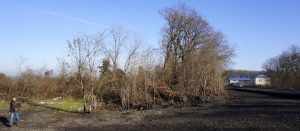
A view showing the nearest vehicle approach to the mass grave site; the roadway is at right. Photo © RJH.
Mass killing events in or near Rudky were recorded several times, in different locations. A first execution of 39 Jews took place in July 1941 at a site 3km from the town; the direction is not specified but the distance matches the current memorial location. Thereafter, additional executions were witnessed in the old Jewish cemetery of Rudky from time to time, according to testimonies recorded in 2009 by Yahad – In Unum.
The final ghetto liquidation took place on 09 April 1943, when about 1700 Jews were driven to the execution site and murdered over prepared ditches. The site was recorded in some documents (including the Rudky Yizkor Book) as “in the forest near Brzezina”, but most of the local population still refers to the area where the monuments were built as “Buhaichuk” (a village called Brzezina during the interwar period and now named Berezyna is 50km from Rudky, an unlikely transport destination).
After the war and until Ukraine declared independence from the USSR, the semi-forested area adjacent to the mass grave served a mixture of uses including as a clay quarry for brick-making. Clay excavations continued toward the roadway until machinery exposed human remains from the mass grave and the digging was halted. In 1991, the large memorial monument was assembled at the site; since then the site has been largely untouched, and seldom visited.
Current features of/at the site: The major roadway H13 passes 60~70m south of the monument, and a shallow ditch runs along the road. The fairly flat land north of the road is cut by a steep downward slope (the edge of a clay quarry) at the northern perimeter of the monument; some upright Jewish headstones which make up the rear wall of the monument have fallen backward and down the slope. Other headstones remain upright, and two rows of headstones originally placed horizontally in front of the rear wall remain in place. A large horizontal memorial plaque also remains, as well as a portion of a square column memorial. The entire monument area and the surrounding land is covered with a dense overgrowth of wild trees, shrubs, and grasses, except where recent project work has cleared around the monument.
Details of the project: The Yizkor Book for Rudky includes a photo of a woman standing next to a square molded-concrete memorial column erected at the mass grave site in 1944 (i.e after the German retreat), according to the caption in Hebrew. Details of the later and much larger memorial project are scarce, mostly gleaned from a JewishGen KehilaLinks page last updated in 2009 by Hanna Gafni which shows small photos and mentions a visit by Jewish descendants. Jewish headstones taken from the old cemetery in Rudki during the German occupation had been used to strengthen the roadbed around and behind the Gestapo headquarters building in town. The headstones were recovered years later when the parking area behind the building was excavated; these headstones were moved away from the parking area and then to the mass grave site. A lapidarium monument was assembled in 1991 at the mass grave site on the initiative of Jewish survivors and descendants in Israel, with about 30 headstones placed upright in a row as a simple unmortared wall at the edge of the elevated area, and another two rows of stones were placed horizontally on the ground in front of the wall (using about 90 headstones in total). In front of the lapidarium, a horizontal concrete pad was cast and into the top face a large slate plaque was inserted, commemorating the destroyed Jewish community. Either at the time the lapidarium was constructed or some time after, additional recovered Jewish headstones were stacked to the side of the monument site, apparently for lack of a more suitable place to take them. A single very small photo exists from the original monument construction; visible in the photo is the 1944 square memorial column, missing its base and its pointed cap.
In 1996, a visit to Rudky was organized by Jewish descendants to rededicate the memorial site. Photos from this visit, five years after the monuments were constructed, showed that vegetation was already growing between the horizontal headstones, that some of the vertical headstones had already fallen. The 1944 column monument was not visible in the few available photos.
In 2017, while he was working to research and document the Jewish history of Rudky and Komarno, Volodymyr Kogut visited the memorial site and discovered its ruinous state; he pledged to improve the site as best he could. Subsequent visits that year confirmed that the monuments were still in place in a state similar to the 1996 condition, but with more vertical stones fallen and with tall trees and dense vegetation growing throughout the site. The flat slab with plaque and the residual portion of the molded-concrete column monument pictured in 1991 were also still present in 2017, though severely overgrown with vegetation.
In 2019, the Lviv Volunteer Center (LVC) brought several of their volunteers together with Mr. Kogut and two additional volunteers from Rohatyn Jewish Heritage (RJH), and used a chainsaw to cut down trees around the monuments plus hand and motor tools to cut lighter vegetation at the site. Cut vegetation was cleared away from the site and disposed of at the bottom of the adjacent slope. No attempt was made to reset the fallen headstones, as the volunteer group lacked tools and equipment for heavy stone work.
Issues encountered in the project: Vegetation clearing proceeded well in 2019 and the site was substantially cleared of trees as well as both light and heavy shrubs and grasses. Tree felling was managed so that none of the monument pieces sustained any damage. Heavy lifting equipment and possibly mechanized equipment will be required to raise and reset the fallen vertical headstones. Skilled stone masons will be required to anchor the vertical headstones in a more permanent fashion. Overall, a sustainable repair or reconstruction project will require engineering and stone conservation skills and materials, plus a long-term commitment from the Rudky town administration and/or regional heritage NGOs plus funding from several local and international sources. Mr. Kogut has participated in heritage networking roundtable events in the region and has developed an outline plan for the site, and in 2018 he was honored with a heritage award from the City of Lviv for his efforts in Rudky, but the project still lacks local and international engagement and support.
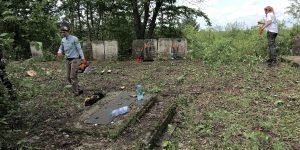
Volunteers with the LVC working to clear vegetation covering the memorial site in 2019. Photo © RJH.
Project costs, one-time and sustaining: Nothing is currently known of costs to assemble the original monuments at the memorial site. Costs to clear vegetation in the 2019 project organized by the LVC were negligible, as all of the labor was volunteer; miscellaneous costs consisted only of transportation for the volunteers plus fuel and supplies for the motor tools.
Current risks to preservation: Absent a new reconstruction project to reset the lapidarium into a more solid foundation, the large monument erected from recovered Jewish headstones will continue to disintegrate and stones will continue to slide down the adjacent steep ground slope. Without an active sustaining project to maintain the monuments and the memorial site, vegetation will continuously overgrow the site, blocking access and damaging the monuments. The horizontal headstones which make up the front portion of the lapidarium are at risk of surface damage from foot traffic while they are partly obscured by vines, fallen leaves, and growing mosses, and from disruption by plant roots underneath. Recurring efforts to clear vegetation or practical landscaping plans to replace wild plants with slow-growing ground cover or inorganic layers are needed, else the site will again disappear under rampant growth. The site lacks visibility from the road, signage to identify the site, and additional signage to explain the site’s history to local people and visitors from abroad. Unless the local civic community can be engaged to maintain and care for the site, the original monuments and their memorial function will be lost.

The mass grave memorial site in the forest near Ralivka shortly after clearing in 2017
and then with new wild vegetation growth only two years later. Photos © RJH.
Related projects in western Ukraine: A large number of Jewish cemeteries and mass grave sites in western Ukraine have become nearly invisible due to ongoing vegetation growth, lack of directional, identification, and information signage, and lack of easy access. Some monuments which were previously constructed to commemorate the dead and their Jewish communities at these sites continue to decay and disintegrate for lack of ongoing maintenance and care. In the forest near Rudne (Lviv oblast), a well-built monument at a mass grave site has suffered chipping and other light damage; the place is known only to local people as there are no signs to identify it and the paths which lead to it are not maintained. Stone markers placed adjacent to the mass graves in the Ralivka forest near Sambir (Lviv oblast) were vandalized, in part because the graves are adjacent to a popular informal recreation area and despite an information sign at the road entrance to the forest. Some Jewish cemeteries become inaccessible and essentially invisible due to dense wild overgrowth, until major clearing projects are organized; the cemeteries near Shchyrets and Stara Sil are examples in the Lviv oblast, but there are examples all over western Ukraine.
Related projects outside western Ukraine: Generally, monuments at mass graves in Jewish cemeteries tend to see more care and maintenance than those at killing and burial sites in forests, fields, and other rarely-visited places. At the mass grave outside of Slavuta in the Khmelnytskyi oblast of Ukraine, for example, the large steel monument installed there now slowly corrodes in a landscape which, thanks to the sandy soil, has few trees growing wild, but the walkways are settling and grasses grow tall, while sand is excavated nearby for local building projects. At Klevan in Ukraine’s Rivne oblast, a sculpted plaque was installed on the former synagogue which was set on fire by Germans during the war, killing the Jews trapped inside, but no project has been started to preserve the building even in a ruined state, so that now both the synagogue and the memorial are at risk of complete loss.
References
-
Етнічна Історія Євреїв Самбірщини: Місто Рудки Та Село Підгайчики (Ethnic History of the Jews of the Sambir Region: The Town of Rudky and the Village of Pidhaichyky) – historical research by Volodymyr Kogut, completed in 2019 for a Master’s degree from Ivan Franko National University of Lviv; includes numerous footnoted references including to Голинський В., «Історія Рудок», 2010 (V. Golynskyi, “A History of Rudky”, 2010)
- Jewish Cemeteries, Synagogues, and Mass Grave Sites in Ukraine – a 2005 survey report authored by Samuel Gruber and others via the World Monuments Fund for the United States Commission for the Preservation of America’s Heritage Abroad
- RUDKI, Lviv Oblast: RUDKY, РУДКИ , RIDIK , RIDUK, RUDIK – survey data for Rudky from the US Commission report (above), including the surveyor’s original notes, on the website of the International Jewish Cemetery Project of the International Association of Jewish Genealogical Societies (IAJGS)
- Rudki and Komarno: USHMM Encyclopedia of Camps and Ghettos, 1933–1945 – brief but formal histories of events in the Jewish ghettos of Rudki and Komarno and at killing sites in the district during the German occupation of eastern Poland (today’s western Ukraine), by the United States Holocaust Memorial Museum and Indiana University Press; the towns are covered in Volume II, Part A, Section III: General Government, Eastern Galicia Region, pp.793-795 (Komarno) and pp.823-824 (Rudki)
- Execution of Jews in Rudky – interviews with local witnesses in and around Rudky to executions and burials of Jews during the Holocaust, by the research organization Yahad – In Unum
- Rudki Memorial Book: Of the Jews of Rudki and Vicinity – an incomplete English translation of the Yizkor Book for Rudky and surrounding villages, on the JewishGen project page for Yizkor Book translations; from the original Yiddish, Hebrew, and English book published in Israel in 1978, edited by Josef Chrust, in an image set archived by the New York Public Library; see also a partial translation of “Rudki during the war years” on the JewishGen KehilaLinks website (below)
- Rudki [Ridik] – the JewishGen KehilaLinks website maintained by Jewish survivors and descendants of Rudky; includes images of the memorial monument in 1996 plus maps and other info
- South-West of Lviv – Between Hope and Depression – an image and text report on a 2017 visit to Rudky and other regional Jewish sites, by photographer and blogger Christian Herrmann for his web project Vanished World
- Rudky Heritage Projects Seek Jewish Descendants – 14Aug2017 Facebook album and text by Marla Raucher Osborn of Rohatyn Jewish Heritage, including Rudky heritage site photos by Volodymyr Kogut
- Facebook post 25Nov2017 – on a tour of Jewish Rudky with Volodymyr Kogut including a visit to the mass grave site north of town, posted by Marla Raucher Osborn of Rohatyn Jewish Heritage
- Facebook post 27May2019 – on the LVC-led clearing of wild vegetation at the Rudky Jewish mass grave site, posted by Marla Raucher Osborn of Rohatyn Jewish Heritage
- Facebook post 03Jun2019 – on the need for additional support to repair and maintain the Rudky Jewish mass grave site, posted by Marla Raucher Osborn of Rohatyn Jewish Heritage

